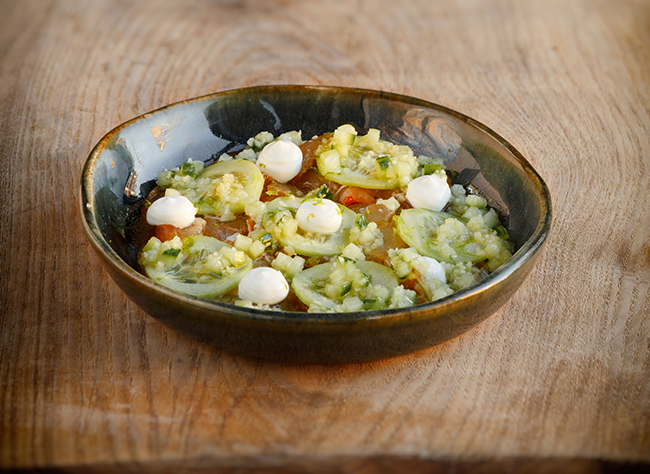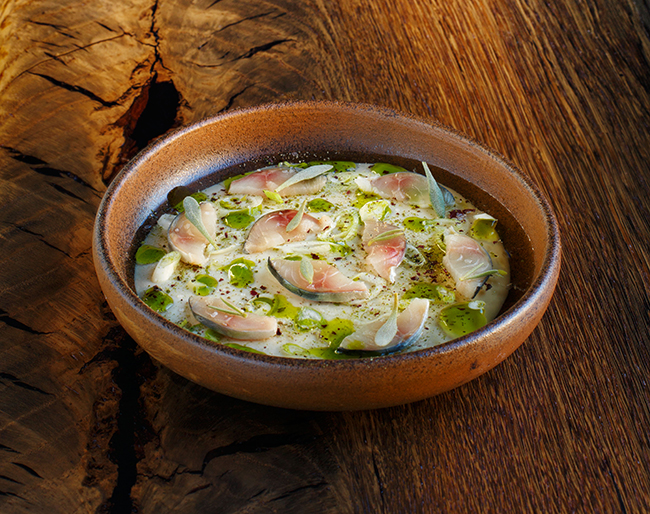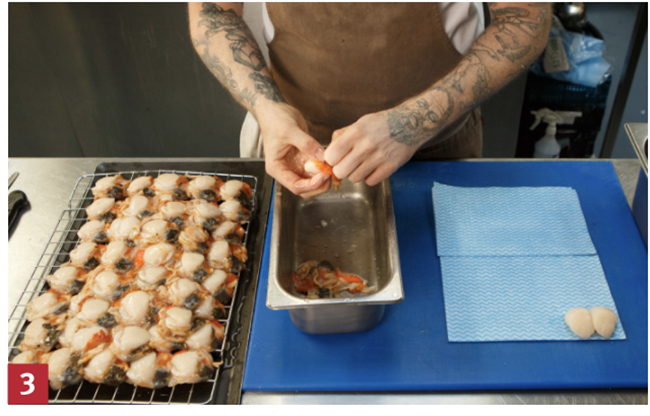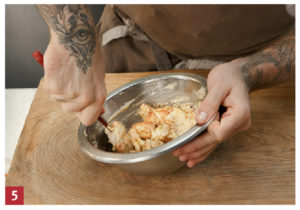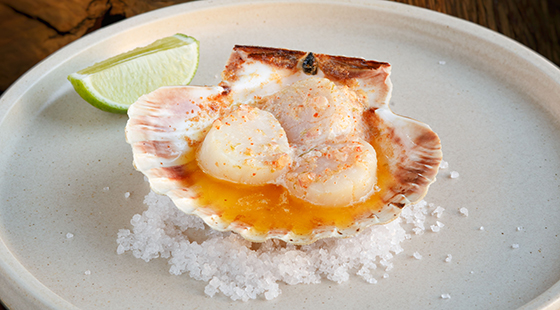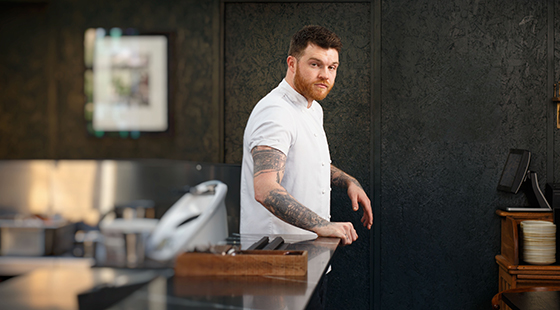Miniature masterpieces: A masterclass on seafood small plates with Tom Brown
Tom Brown's small plates menu at Cornerstone in east London is a hymn to the fruits of the sea, offering beautifully presented dishes that are designed for sharing. Michael Raffael reports
Tapas? Pintxos? They've both entered the everyday repertoire of restaurant-speak. "Platos para compartir", or "sharing plates", isn't such a familiar expression, but it is to any Spaniard eating out. At its most basic, it may be a plate of patatas bravas with a bottle of San Miguel. In San Sebastián, Barcelona or Madrid bars, it's often a succession of single plates, served informally, that add up to a meal.
Tom Brown, head chef at Cornerstone in London's Hackney Wick, first came across tapas when he worked for Rick Stein's chef, Paul Ripley, at the short-lived Seafood Bar in Falmouth. The food was great, but the ambience, above a busy fish and chip restaurant, didn't cut it.
"You can't have a small plates menu without a buzzy restaurant," Brown argues. Unlike a tasting menu that has a built-in formality with its focus on the cuisine, he wants his honed cooking to be a social occasion where the couple at table two or the group at table six have a great time.
A nouvelle cuisine 30cm plate with a few delicately arranged morsels may verge on pretentious, but a traditional main course, Brown believes, can be just as off-putting: "When you start eating it, it may be amazing, but by the end, every mouthful is the same," he says.
He wants his small, cazuela-style plates to sustain and enhance his customers' enjoyment without dominating it. The keys to this are setting the portion size and style of presentation that allows diners to 'dip in'.
Menu planning
Open Tuesday evening to Saturday, the menu at Cornerstone - as one would expect from a Nathan Outlaw protegé who was executive chef at the Capital hotel in Knightsbridge for three years - revolves around fish. It features eight to 10 sharing plates - two of which are cold - bread and an oyster dish. Waiters recommend that a table of two order eight dishes.
The kitchen is designed as an island in the centre of the restaurant so that all dishes are finished in view of the customers' tables.
Costs
Cornerstone prices menu items separately, ranging from £4 for olives and £5 for a pickled oyster to £17 for roast Cornish hake. Desserts are £10.
In the evenings there's the option of a £48 eight-plate menu. That price reflects the average food spend.
Brown budgets for a 70% gross profit that takes into account the significant cost of perishable fish with its inevitable risk of wastage.
Soy-cured gurnard
There are three main species of gurnard: red, grey and tub. Cornerstone uses the large and meaty tub gurnards, finely sliced like sashimi.
Cornerstone makes batches in multiples of 12 portions. A kilo (roughly) of skinned gurnard fillets are cured for four hours in a cold Kikkoman and honey reduction (at a ratio of 2 soy: 1 honey, reduced by half).
The gurnard are laid head to tail on a sheet of film, rolled up to form a sausage and then frozen. The fish is then sliced on the machine to prosciutto thickness and coated with a sake vinegar-oil dressing and grated lime zest. The dish is finished with strained Greek yogurt and a cucumber-lime juice brunoise.
Mackerel pÁ¢té
This is more like a parfait in texture than a traditional coarse fish pÁ¢té. Cornerstone works with a batch size of 14-15 filleted, medium-sized (300g) fish. Cure the fillets in a 50/50 solution of sugar and still Breton cider for 20 minutes. Reserve four fillets for finishing. Grill the rest skin-side down until the skin starts to smoke. Blend until completely smooth and season with lemon juice, horseradish and salt.
Make a dry seasoning of roughly blended dulse, nori, kombu and lettuce.
Make a light jelly of cider and sugar, with two softened gelatine leaves per litre.
To finish the dish, spread the paté over the base of cazuela-style dish and chill. Spoon a light coating of the jelly on top just before it sets. Sprinkle with seaweed seasoning. Add slices of cured mackerel fillet cut across the grain and drops of seaweed oil.
Barkham Blue cheese
The cheese course is one of four desserts and the portion is large enough to share, but Cornerstone would normally recommend it as a stand-alone dish.
Barkham Blue was Supreme Champion at the 2015 British Cheese Awards. It's served with a quince poached in muscat wine compote, a miniature Eccles cake and ruby port syrup.
Treacle bread 250g Shipton Mill's Malthouse flour
250g self-raising flour
50g oats
2tbs dark treacle
1tsp salt
To accompany the mackerel pÁ¢té. Make a lightly mixed dough. Spoon into muffin hoops on a baking sheet and bake at 170°C forced convection.
Baked scallops in the shell, coral butter
Brown only buys diver scallops for Cornerstone, working with batches of 30-50. Their size can vary so he will serve either two halved or three whole scallops per portion.
To prepare the scallops: open them in the usual way. Insert a sharp knife (a stiff-bladed butcher's knife is ideal) against the flat shell and free the scallop (1). Discard the flat shell. Scoop out the whole scallop with its coral and mantle attached (2). Clean the rounded shell.
Pull off the mantle and coral together (3). Reserve the coral and dry overnight on the hot plate or similar (4). Grind to a coarse powder.
For each order, stand the rounded shell on a hoop set on a stainless steel flat (7). Put the scallops in the shell. Add a scant tablespoon of dry white wine and a 10g-15g slice of coral butter (8). Bake in a hot oven till the butter has melted. Take out of the oven and baste thoroughly (9).
Return to the oven to finish cooking. Serve each shell on a bed of salt. Accompany with a wedge of lime (10) .
At the table, waiting staff encourage customers to squeeze lime juice on the scallops to enhance the flavour.
Tom Brown
"I don't like stuffy restaurants where you feel uncomfortable, so I wanted to create an environment where anyone can come in, feel at ease, read a menu they understand and that they relate to, and have a good time," explains Tom Brown.
On paper it reads like a mission statement with which most chefs-patrons could agree. In Brown's case, it's based on his personal experience as a customer. "When I was quite young, me and my girlfriend at the time went to a restaurant. The waiter wouldn't give us the time of day, but the obviously wealthy couple at the next table were getting the full works. And I thought: this isn't right; we're paying the same money and eating the same food."
At the time he was a junior chef working for Nathan Outlaw in Port Isaac, Cornwall, en route to becoming his head chef at the Capital. The ties to his mentor have remained strong. He turned to Outlaw for advice when planning a business model for Cornerstone and many of the recipes he uses have evolved from his time working under him.
The concept of his Hackney Wick restaurant in east London is very much his own: "I wanted to put all the things I like about eating out into it and get rid of everything I don't."
His dos and don'ts list is wide-ranging. He doesn't, he says, want the chef's big ego to be looking up at the customer from the plate. He doesn't want a pecking order of tables in the dining area, which privileges some at the expense of others. He wants the meal experience to matter as much as the cuisine.
His island-designed kitchen, just large enough for his brigade of four, maintains the equilibrium between those who cook and those who serve. It also, he insists, reflects his temperament: "I'm a worrier and like to know what's going down and that everything is perfect. When I worked in closed kitchens I was always asking: how is table X or Y? Now I've taken that stress away, I can adjust the service to individual tables because I can see and read the people sitting at them."
The format, like everything at Cornerstone, is an extension of his personality. A kneehole desk and antique long case clock came from his grandmother's house, and the sale of the house, along with support from his family, helped finance him. Having invested so much of himself in the business, he's shrewd enough to realise that opening a Mk II lookalike wouldn't work: "If I treated it as a concept and shoved it into Shoreditch or Brixton, it wouldn't be the same. You couldn't bottle the magic of this place."
Flying solo: Tom Brown brings a taste of Cornwall to Hackney with Cornerstone >>
On a roll: Gary Usher's masterclass for a roast stuffed pork belly >>
Get The Caterer every week on your smartphone, tablet, or even in good old-fashioned hard copy (or all three!).


